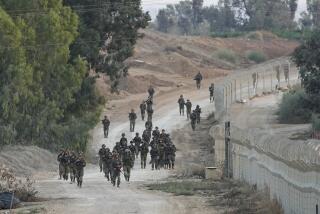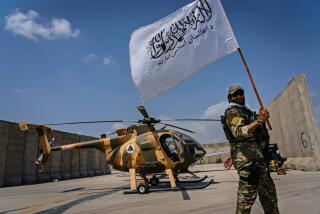Bin Laden May Use Stone Age Tactics to Elude High-Tech Hunt
WASHINGTON â In its accelerated pursuit of suspected super-terrorist Osama Bin Laden, the United States is prepared to use its full panoply of high-tech tools: Spy satellites. Communication intercepts. Long-range weaponry. Perhaps even âcyber-warâ attacks on his financial infrastructure.
Already, the United States has fired cruise missiles at sites linked to Bin Laden in retaliation for the bombings of U.S. embassies in Kenya and Tanzania. Intelligence officials have used advanced surveillance techniques to monitor his conversations and track the movements of his followers. Even before the Aug. 7 embassy bombings, they reportedly drew up plans to send U.S. forces to Afghanistan to extricate Bin Laden, but the proposal eventually was rejected.
Yet Bin Laden, the Islamic extremist accused of masterminding not only the embassy attacks but other acts of terrorism from a command post in the Afghan mountains, appears to have a potent defense against the worldâs most fully equipped modern power, U.S. officials acknowledge.
He can simply retreat into the Stone Age.
U.S. officials fear Bin Laden has the ability to neutralize much of his pursuersâ advantage by burrowing deeper into the jagged Afghan landscape, limiting his use of vulnerable communication links and demobilizing an already loose-jointed 5,000-member organization to minimize the damage that might be done to it by informants or military assault.
Such maneuvers would sharply hinder the efficiency of Bin Ladenâs organization. Yet they would have only a modest effect on its ability to carry out what U.S. officials characterize as a very low-tech, albeit lethal, mission--to bomb and harass Americans and other foes.
U.S. authorities have claimed early success in their pursuit of Bin Laden, with the apprehension of several key suspects in the embassy bombings. But Bin Ladenâs apparent ability to adopt a primitive survival strategy raises questions about whether the United States--in this anti-terror campaign and those that are likely to follow--truly has the punitive power it claimed last month when it let fly the 79 cruise missiles of âOperation Infinite Reach.â
âIf they fight us in this century, itâs no contest,â one defense official said. âBut if they turn back the time machine, they can make the odds a lot different.â
Satellite Photos of âTerrorist Universityâ
In the run-up to last monthâs attack on targets in Afghanistan and Sudan, U.S. officials used Bin Ladenâs sporadic public appearances, and his reliance on high-tech tools, to their advantage.
The United States had accumulated valuable intelligence on Bin Laden using spy satellite photos of his âterrorist university,â which the officials showed off when they briefed the public after the attack.
They used their communications intercept capacity to pick up calls placed by Bin Laden on his Inmarsat satellite phone, despite his apparent use of electronic âscramblers.â Bin Ladenâs voiceprint, which can be used to identify his phone calls, is widely available because of interviews he has given on television.
The Saudi-born financier has appeared to relish visibility, as underscored by past interviews and a public statement he issued after the U.S. attack. Such appearances clearly have a purpose: They keep his far-flung operatives and potential volunteers aware of his presence and keep them focused on the cause of anti-Western fundamentalism.
But now, Bin Laden can quickly scale back reliance on satellite phones and the laptop computer he is believed to use. He can rely more heavily on emissaries to convey personal messages and turn to lesser-known aides to issue public pronouncements.
In bombing an alleged training camp in Afghanistan, Clinton administration officials said they wanted to disrupt a facility that was instructing as many as 600 fighters at a time in the use of firearms and explosives, as well as serve notice on Bin Laden that the West is watching him.
Reports from the region suggest that Bin Laden wants to simply rebuild the camps, with stepped-up security. But officials acknowledge that if he decided the risks have become too great, he could quickly move out and relocate some of the most important camp functions to caves or underground bunkers. And he also could break up his organization into smaller groups and disperse them in the mountains.
Reported Training Called âLow-Techâ
In the network of camps, Bin Laden is not protected by the kind of multistory reinforced underground bunkers that Iraqi President Saddam Hussein has built to protect his staff and command and control communications, one U.S. official noted.
But âhe doesnât need it like you do in downtown Baghdad. . . . The Russians tried to blast [Afghan fighters] out of those hills for years, and they couldnât do it,â the official said.
The explosives and firearms training allegedly given to Bin Ladenâs warriors, and most of the groupâs communications, âare all basically very low-tech,â said Kenneth Katzman, a Middle East expert and former CIA official at the Congressional Research Service. The instructors âdonât need some big layout to teach people how itâs done.â
The rudimentary organizational structure that Bin Ladenâs network has been described as having could also frustrate efforts to bring him to justice.
Military organizations and even drug gangs must rely on closely knit hierarchies to keep daily operations going. Bin Ladenâs alleged network is apparently far looser, composed of some members who belong to other terrorist groups and others with weaker affiliations. They are said to get money from Bin Laden, but many apparently get little or nothing in the way of detailed operational orders.
Bin Ladenâs inner circle may be quite small, consisting of perhaps no more than a handful of warriors with assault rifles who are regularly on the move, some analysts believe.
âThis is an ad hoc, hydra-headed organization,â Katzman said. âThey can melt into the mountains, they can do nothing for a while, and it doesnât hurt the cause.â
Clearly, one of Bin Ladenâs greatest vulnerabilities is his widespread network of businesses and investments, which consist of legitimate ventures and, according to some reports, criminal enterprises, such as Afghan drug-running.
Bin Laden canât neglect these businesses, because he needs the revenues they generate to maintain his authority in the world of radical Islam. But analysts say he can lower his risks by conducting transactions in an ancient style, with wads of cash carried by intermediaries, known as âcutoutsâ in intelligence parlance.
He would probably be able to maintain operations even if some parts of his empire were cut off, since the terrorist activities he allegedly sponsors are relatively inexpensive. While the U.S. government spent $80 million on the cruise missiles alone, the Aug. 7 embassy attacks that killed hundreds probably cost only several hundred thousand dollars to execute, analysts say.
Even so, U.S. officials say they have many tactical weapons they can deploy against Bin Laden.
If cruise missile strikes wonât work as well next time against a more alert, more hidden foe, the United States may be able to penetrate his network by going after the individuals in some of its cells.
Authorities may now have valuable leads provided from key suspects captured after last monthâs bombings. These officials doubt that Bin Laden will maintain a low profile, and they say he may attempt more attacks that would make him vulnerable.
The United States hopes to enlist Afghanistanâs ruling Taliban militia, which has mixed feelings about Bin Laden, and the Pakistani government in the effort to bring him to justice.
With the United States investing huge resources and assigning top priority to the case, some experts predict it is only a matter of time before Bin Laden is run to ground. Eventually, U.S. officials were able to nab Mir Aimal Kasi, the Pakistani who gunned down employees outside CIA headquarters, and Ramzi Ahmed Yousef, the mastermind behind the World Trade Center bombing, analysts say.
Yet one U.S. official remains cautious in predicting success for the effort. âHe has a lot of operatives in a lot of places, and he is not an easy target,â this official said.
Some outside analysts say authorities will need more favorable breaks to bring this case to a successful conclusion.
Despite the missile missionâs code name of âOperation Infinite Reach,â said Andrew F. Krepinevich of the Center for Strategic and Budgetary Assessments, a Washington think tank, âthis may be a case of reach exceeding grasp.â
More to Read
Sign up for Essential California
The most important California stories and recommendations in your inbox every morning.
You may occasionally receive promotional content from the Los Angeles Times.











